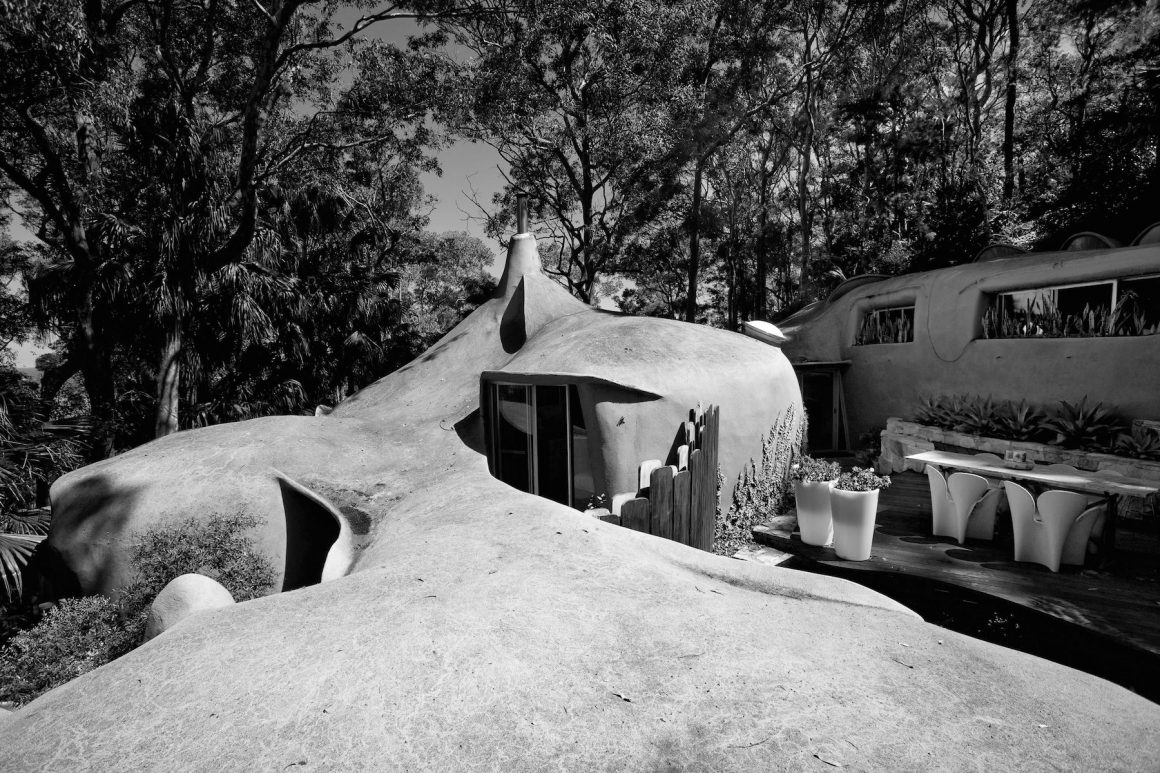The Hollander House, built in the late ’60s by architect David Hollander, is an icon of Australian organic architecture – and is now up for sale.
The adventure of arriving at Hollander House begins with the drama of Grandview Drive and an arrival under the architect’s shell-roofed garage supported by three hand-formed ferro-cement columns that immediately evoke memories of the Antonio Gaudi’s Barcelona architecture. The surprises continue with the rounded corners of the asymmetrical front door and the lobular timber panels of an adjacent gateway.
Inside, Hollander’s interior architecture continues this adventuresome exploration of the site’s potential by following the site’s slope through a terrain-embracing floorplan. While each zone of living space is universally functional and efficient; the materials, the internal spaces, and their individual views into surrounding bushland are calibrated to the setting. Using the definition popularised by the American architect, Frank Lloyd Wright, it fulfils all of the criteria of an ‘organic’ house developed specifically for the site.
The architect’s ambitious exploration of elliptical geometry working in the medium of steel-reinforced cement is a near-ideal fusion of medium and architectural intent. The interiors and exteriors are carefully calibrated to create a building that grows out of the site. As Frank Lloyd Wright said of organic architecture, “No house should ever be on a hill or on anything. It should be of the hill.” Hollander’s house at 81 Grandview Drive fulfils that criterion.
“I’m still convinced that poured concrete will be a viable, economical alternative material in domestic architecture“, said once David Hollander.
He developed a floor plan enveloping three levels beginning at the entrance hall and office, continuing through the living area to the kitchen/dining area, and ultimately ascending to the casual recreation room at the highest elevation. The elliptical walls are not governed by mathematics but as the architect told a journalist in an interview as the house was nearing completion, “I chose curves which I thought were correct aesthetically”. His multiple levels have been carefully displaced to allow internal long views and vistas.
The interior architecture of domestic settings, large and small, have hierarchies and in the case of Hollander’s house, the social centre is the lounge with its free-flowing hearth which, evidenced by the spotless chimney breast, draws perfectly allowing little or no smoke to escape into the room. By carrying the heat and smoke through an internal masonry channel to the steel chimney, the fireplace also allows the passive capture of heat to warm the house for hours after the fire has been extinguished. Facing the fireplace, the architect designed circular seating that fosters social interaction or in the absence of guests, encourages lounging.
The house’s exterior finishes are also laid over the hand-shaped roof and wall forms but unlike the interior, they are finished with a more granular cement render. The architect has paid close attention to the roof drainage of water by designing and forming functional furrows and drip-lines over the porch overhangs, doors, windows and other appropriate areas. The centuries-old drip-line technique, known from traditional stonemasonry, avoids water drips over and under window and door openings.
While a home office is adjacent to the front entrance, the private zones for the bedrooms, baths and the informal recreation space are tucked away behind and appropriately distant from the public spaces. Most of these rooms open onto private decking enveloped by the exterior walls and the surrounding sandstone escarpment.
The current owner, a professional interior designer, has kept the faith with Hollander’s vision and worked assiduously to recover elements of the original design. “I found a 1972 magazine article on the house,” she recently told an interviewer and “that allowed me to see what it originally looked like.” The interior designer also revived the architect’s original lighting plan keeping the patinated copper fixtures and adding new elements in the same scale and material.
All images were shot by and are courtesy of © Jennifer Soo.
